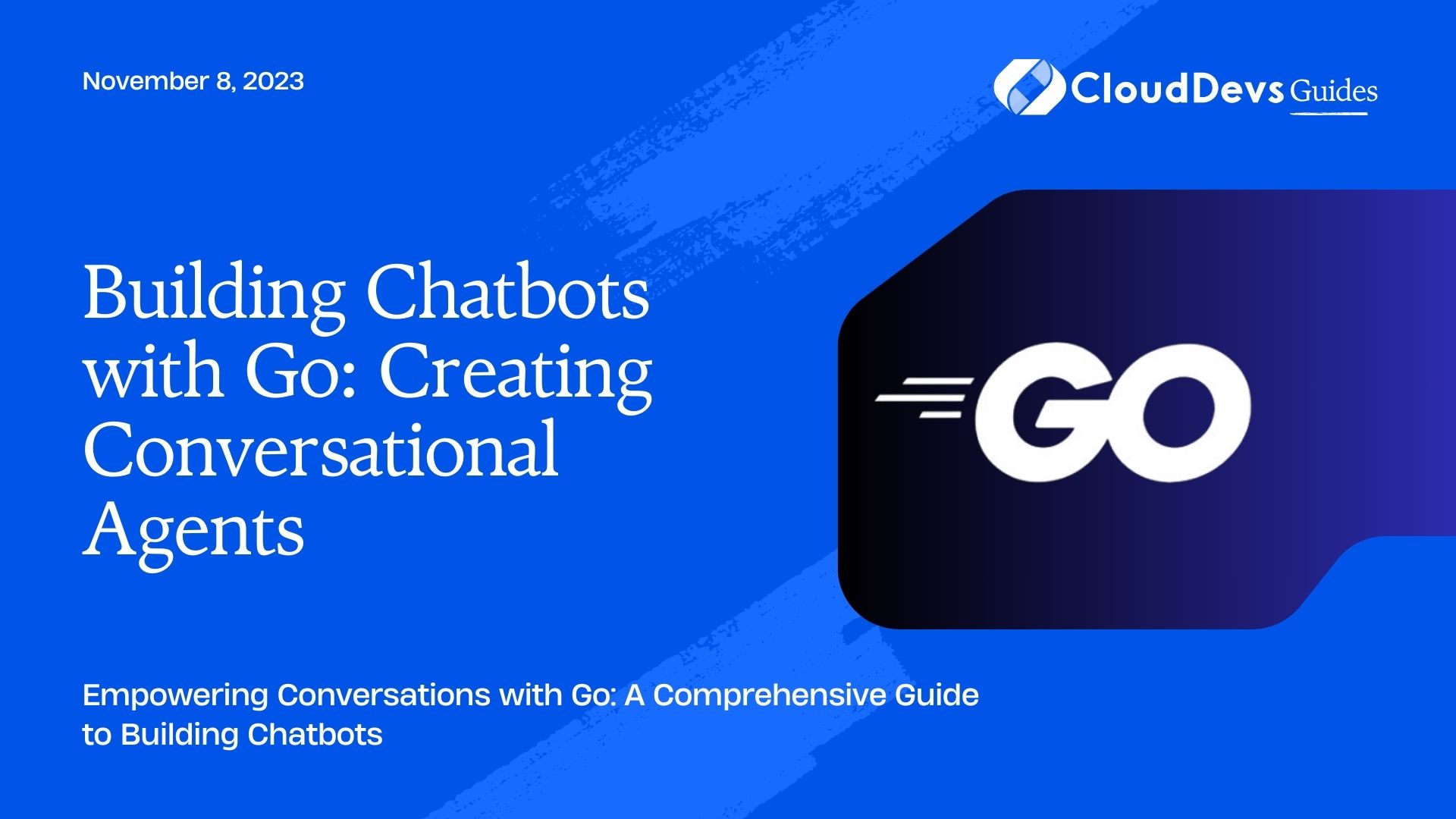How can I build a Chatbot with Go?
In the age of digital transformation, chatbots have become essential tools for businesses to enhance customer support, automate tasks, and engage users effectively. They serve as conversational agents that can interact with users in a natural language, making them a valuable asset for any organization. In this blog post, we will delve into the world of chatbot development using the Go programming language. We’ll cover the fundamentals, explore essential concepts, and provide you with code samples to kickstart your chatbot project.
1. Introduction to Chatbots
1.1. Understanding Chatbot Basics
Chatbots are computer programs designed to simulate human conversation. They interact with users through text or voice interfaces and can perform various tasks, such as answering questions, providing recommendations, or executing actions based on user input.
1.2. Use Cases of Chatbots
Chatbots have found applications across multiple industries and domains:
- Customer Support: Chatbots provide instant assistance to customers, answering frequently asked questions and routing inquiries to human agents when necessary.
- E-commerce: Chatbots can help users find products, place orders, and track deliveries.
- Healthcare: They can provide health-related information, appointment scheduling, and medication reminders.
- Finance: Chatbots assist in checking account balances, making transactions, and providing financial advice.
2. Getting Started with Go for Chatbots
2.1. Setting Up Go Environment
Before we dive into chatbot development, ensure you have Go installed on your system. You can download it from the official Go website (https://golang.org/).
2.2. Choosing a Chatbot Framework
Selecting the right framework is crucial for chatbot development in Go. Some popular options include:
- GoBot: A versatile chatbot framework for Go that supports multiple messaging platforms.
- Dialogflow: Google’s NLP-based platform that integrates seamlessly with Go.
- Wit.ai: Facebook’s NLP platform, also compatible with Go.
3. Building the Chatbot Logic
3.1. Handling User Input
In Go, you can capture user input through various means, such as HTTP requests, command-line interfaces, or messaging platforms. Here’s a simple example of handling user input via HTTP:
go
package main
import (
"net/http"
"io/ioutil"
"fmt"
)
func main() {
http.HandleFunc("/chatbot", func(w http.ResponseWriter, r *http.Request) {
body, err := ioutil.ReadAll(r.Body)
if err != nil {
http.Error(w, "Error reading request body", http.StatusBadRequest)
return
}
userMessage := string(body)
// Process userMessage and generate a response
response := processUserInput(userMessage)
// Send the response back to the user
w.Header().Set("Content-Type", "application/json")
fmt.Fprint(w, response)
})
http.ListenAndServe(":8080", nil)
}
func processUserInput(input string) string {
// Your chatbot logic here
return "Hello, I'm your chatbot!"
}
3.2. Processing Responses
Once you’ve captured user input, your chatbot logic should process it and generate appropriate responses. This can involve invoking APIs, querying databases, or running algorithms to generate responses dynamically.
4. Integrating NLP for Conversational Intelligence
4.1. Using Natural Language Processing (NLP)
To make your chatbot more intelligent and capable of understanding natural language, you can integrate NLP libraries and services. Go offers various NLP libraries like “go-nlp,” which can help you with tasks like tokenization, sentiment analysis, and part-of-speech tagging.
4.2. Leveraging Pre-trained Models
Consider using pre-trained NLP models like BERT, GPT-3, or SpaCy to enhance your chatbot’s language understanding capabilities. These models can save you time and effort in training your own models from scratch.
go
package main
import (
"github.com/dghubble/go-twitter/twitter"
"github.com/dghubble/oauth1"
"log"
)
func main() {
// Create a Twitter API client
config := oauth1.NewConfig("YOUR_CONSUMER_KEY", "YOUR_CONSUMER_SECRET")
token := oauth1.NewToken("YOUR_ACCESS_TOKEN", "YOUR_ACCESS_TOKEN_SECRET")
httpClient := config.Client(oauth1.NoContext, token)
client := twitter.NewClient(httpClient)
// Send a tweet
tweet, _, err := client.Statuses.Update("Hello, Twitter!", nil)
if err != nil {
log.Fatal(err)
}
log.Printf("Tweet sent: %s", tweet.Text)
}
5. Designing the Conversation Flow
5.1. Dialog Management
Effective chatbots maintain context throughout a conversation. Implementing dialog management ensures that your chatbot can handle multi-turn conversations and provide relevant responses based on previous interactions.
5.2. User Context
Store user context and conversation history to make the chatbot’s responses more contextually relevant. This can be achieved using session management and context variables.
go
type UserContext struct {
Name string
Age int
Context map[string]interface{}
}
func main() {
// Initialize user context
userContext := UserContext{
Name: "John",
Age: 30,
Context: make(map[string]interface{}),
}
// Store context variable
userContext.Context["last_order"] = "Pizza"
// Retrieve context variable
lastOrder := userContext.Context["last_order"].(string)
fmt.Printf("Last order: %s\n", lastOrder)
}
6. Connecting to Messaging Platforms
6.1. Integrating with Slack
Slack is a popular messaging platform used by teams for communication and collaboration. You can integrate your Go chatbot with Slack using the Slack API and Bot Tokens.
go
package main
import (
"github.com/slack-go/slack"
"log"
)
func main() {
api := slack.New("YOUR_BOT_TOKEN")
_, _, err := api.PostMessage("YOUR_CHANNEL_ID", slack.MsgOptionText("Hello, Slack!", false))
if err != nil {
log.Fatal(err)
}
}
6.2. Deploying on Facebook Messenger
Facebook Messenger is another widely used messaging platform. You can create a chatbot for Messenger using the Facebook Messenger Platform and integrate it with your Go application.
7. Testing and Debugging Your Chatbot
7.1. Unit Testing
Unit testing is crucial to ensure that your chatbot’s individual components work as expected. Use testing frameworks like Go’s built-in testing package or external libraries like testify for comprehensive unit testing.
go
package main
import "testing"
func TestProcessUserInput(t *testing.T) {
input := "Hello, chatbot!"
expectedOutput := "Hello, I'm your chatbot!"
output := processUserInput(input)
if output != expectedOutput {
t.Errorf("Expected: %s, Got: %s", expectedOutput, output)
}
}
7.2. Debugging Techniques
When debugging your chatbot, consider using Go’s built-in debugging tools like fmt.Println or more advanced tools like delve to set breakpoints and inspect variables.
8. Scaling and Deployment
8.1. Load Balancing
For high-traffic chatbots, implement load balancing to distribute incoming requests across multiple instances of your chatbot application. Tools like NGINX can help with load balancing configurations.
8.2. Containerization with Docker
Containerizing your Go chatbot with Docker simplifies deployment and ensures consistency across different environments. Create a Dockerfile to package your chatbot application into a container.
Dockerfile FROM golang:latest WORKDIR /app COPY . . RUN go build -o chatbot . CMD ["./chatbot"]
9. Monitoring and Analytics
9.1. Tracking User Interactions
Use analytics tools to monitor user interactions with your chatbot. Track metrics like user engagement, response times, and user satisfaction to make data-driven improvements.
9.2. Performance Metrics
Monitor your chatbot’s performance to identify bottlenecks and optimize resource usage. Tools like Prometheus and Grafana can help in collecting and visualizing performance data.
10. Best Practices for Chatbot Development
10.1. Security Measures
Implement security measures to protect user data and ensure secure communication between your chatbot and external systems. Use encryption, authentication, and authorization mechanisms.
10.2. Privacy Considerations
Respect user privacy by clearly stating how you handle user data and obtaining consent when necessary. Comply with data protection regulations such as GDPR.
Conclusion
Building chatbots with Go empowers you to create intelligent conversational agents that can enhance customer experiences, automate tasks, and provide valuable insights. Whether you’re building a chatbot for customer support, e-commerce, or any other domain, Go’s flexibility and robust ecosystem make it a great choice for chatbot development. By following best practices and leveraging NLP, you can create chatbots that engage users effectively and drive business value.
In this comprehensive guide, we’ve covered the essentials of chatbot development in Go, from setting up your environment to deploying and monitoring your chatbot in production. With the knowledge and code samples provided, you’re well-equipped to embark on your chatbot development journey. Stay curious, iterate on your chatbot’s design, and keep exploring new ways to make your conversational agent smarter and more user-friendly.
Start building your Go-powered chatbot today, and unlock the potential of conversational AI in your projects.
Table of Contents







